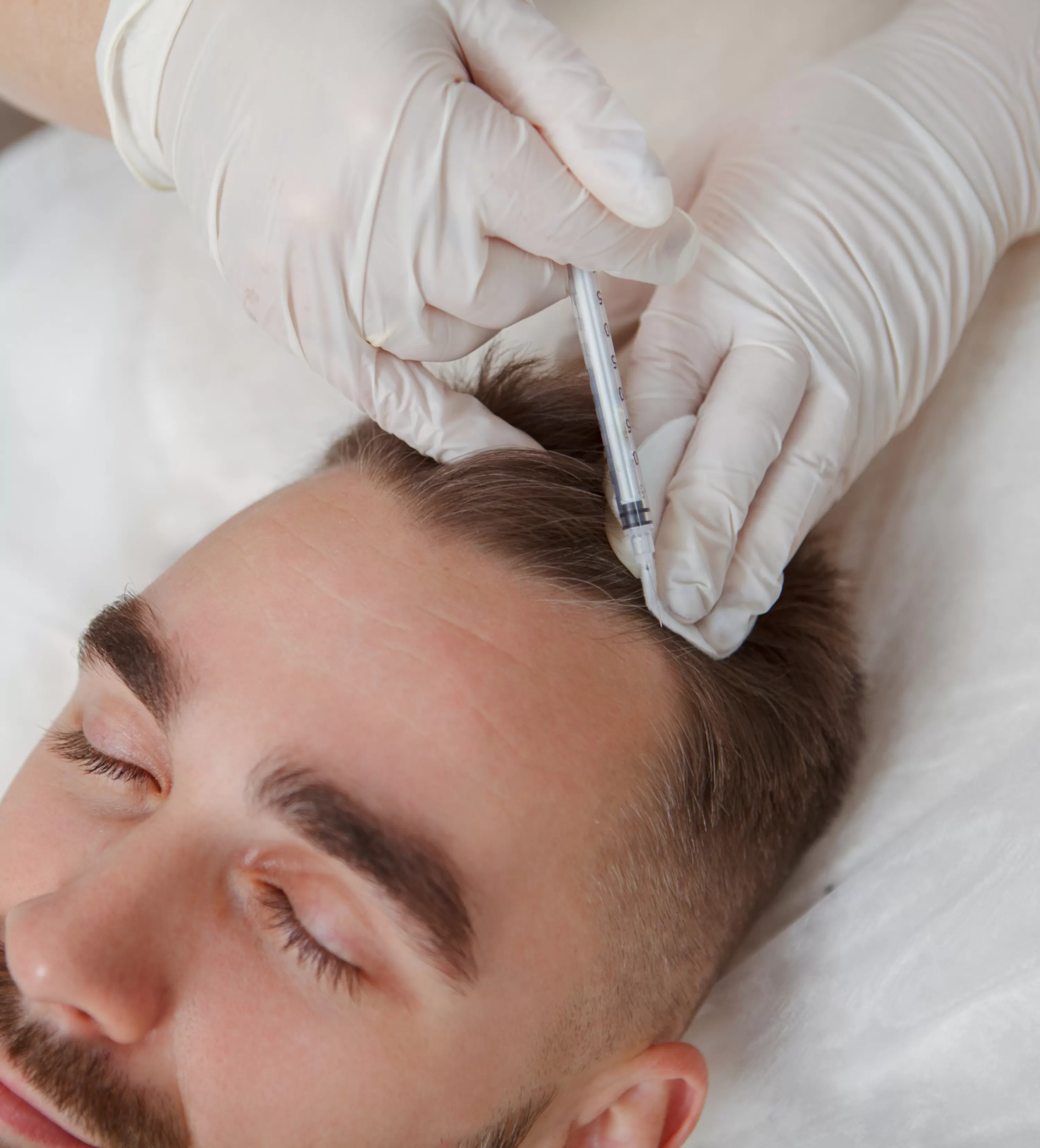Growth Factor Injection (PRP)
Growth Factor Injection (PRP)
Treatment
Platelet Rich Plasma (PRP) for hair restoration has been scientifically proven to improve the growth phase of the hair cycles, improve scalp health and increase hair density and thickness. The platelets within PRP release growth factors within the scalp and hair follicles to stabilise hair loss, improve blood supply and nutrients to the area, rejuvenate dormant hair follicles, leading to an overall increase in hair number and reduced shedding.
How it works?
How it works?
Platelets contain an abundance of growth factors (such of PDGF, TGF, VEGF, EGF, FGF, CTGF), which are crucial for tissue rebuilding and repair. It also contains molecules important for cell migration and proliferation, along with numerous cytokines, anti-microbial peptides, and anti-inflammatory molecules. When injected into scalp, it acts by a variety of mechanisms, including enhancing proliferation and survival of hair follicles. It also acts to increase blood flow to your hair follicles, bringing more nutrients.
Why we use PRP Injection?
Why we use PRP Injection?
Platelet rich plasma offers an additional way to stimulate hair growth, especially in people who does not tolerate other forms of treatment. For example, it may be useful if someone is not a candidate for a hair transplant, cannot use finasteride, or has developed contact allergy to topical solution.
Who is suitable for PRP Treatment?
Who is suitable for PRP Treatment?
- Early stage of male- or female-pattern baldness (androgenic alopecia)
- Sudden hair loss with development of one or more oval bald patches (alopecia areata)
- Generalized thinning of scalp
- Someone who has been on other types of medical treatments such as minoxidil and is looking for other ways to stimulate hair growth
Expected result
Expected result
New hair growth and better hair health can be seen as early as 4 months after completion of treatment. Noticeable results are typically evident between 6-9 months after the treatment and will continue to improve for up to a year. Rarely some patients may experience temporary hair shedding at the beginning of the treatment but this usually self-resolve.
Annual top-up injections are recommended to sustain the hair restoration benefits. Younger patients and patients with more recent hair loss will have better result.
- Treatment Time – 30 Minutes
- Discomfort – Mild
- Recovery – 12 Hours
Preparation & Aftercare
Preparation
Preparation
- Avoid medications that can cause bruising like Aspirin, fish oil, Vitamin E, herbal medications, etc., for a week prior to the treatment.
- Discontinue any non-steroidal anti-inflammatory medication such as Nurofen, Ibuprofen, Celebrex for 2 days prior until 10 days after the PRP therapy.
- Minimal alcohol, caffeine, fatty food and ideally a healthy diet.
- Try to have a good night’s sleep prior to the day of the procedure as it may assist platelet yield
During procedure
During procedure
- Wash your hair in the morning of the procedure and do not apply any hair product
- Topical numbing gel will be applied over the scalp to provide adequate analgesia prior to the injection
- Small volume of blood (15-30ml) is collected in the same way as a standard blood test and PRP are separated from whole blood using a special separating device
- Concentrated PRP is then injected into superficial scalp using very fine and short needle
Aftercare
Aftercare
- It is recommended not to wash your hair for at least 6 hours post-procedure
- You may resume your normal activities, however, avoid any strenuous exercise for at least 12 hours
- If you require pain relief, please use Panadol based medication
- You will not be able to take any anti-inflammatory for 10 days after the procedure.
- Avoid using any topical scalp product or medicated solution for at least 3 days after the injection

Results
Pricing & Packages
Growth Factor Therapy (PRP)
- Scalp PRP Injection $600
Treatment Package
- Package of 3 Treatments combined with LLLT ($475/Treatment) $1425 (save $375)
- Package of 6 Treatments combined with LLLT ($425/Treatment) $2550 (save $1050)
FAQ
Have further questions or want to learn more?
Who may benefit from PRP treatment for hair loss?
- Early stage of male- or female-pattern baldness (androgenic alopecia)
- Sudden hair loss with development of one or more oval bald patches (alopecia areata)
- Generalized thinning of scalp
- Someone who has been on other types of medical treatments such as minoxidil and is looking for other ways to stimulate hair growth
What is the downtime with PRP treatment?
One of the key advantages of PRP treatment for hair loss is that it has minimal downtime and minimal side effect, other than temporary mild inflammation of scalp. Most patients can resume normal activity immediately and even wash their hair 6 hours later.
What is the average number of treatments?
3-6 treatments, 4 weeks apart is recommended. To maintain the effect of treatment we suggest coming back every 6-12 months for a top up.
What have the clinical studies shown?
There have been over 800 research studies to assess if PRP is effective for male and female pattern hair loss and some autoimmune hair loss disorders. The studies have demonstrated that hair density, hair thickness, hair-pull test, level of scalp inflammation and oil secretion were significantly improved for both male and female at 6-9 months after PRP treatment
Is PRP safe?
The procedure is conducted under stringent guideline to minimize risk of complications. There is also little chance of a reaction because the material being injected back into the patient is from their own blood. To meet TGA guidelines, a doctor must be involved in or professionally supervise the PRP procedure.
How long would the result last?
PRP is not a cure for conditions that cause hair loss. For this reason, a person would need to receive multiple PRP treatments over time to maintain hair growth results. The same is true of medications that doctors commonly used to treat androgenetic alopecia, such as topical minoxidil and oral finasteride.
The doctor’s recommendations for how often a person should have PRP will vary depending on a person’s condition and the results of their initial treatment. It is often recommended having maintenance injections every 6 months once hair loss is under control.
How is PRP therapy done?
A small volume (15-30ml) of blood is collected in the same way as a standard blood test. At The Hair Institute, we us a special separating device and a centrifuge, the platelets are separated from the whole blood and are collected in a concentrated sample known as PRP (platelet rich plasma). The PRP is injected back into the superficial scalp using a very fine and short needles after topical anaesthetic gel has been applied. The procedure usually takes about 45-60 minutes.
